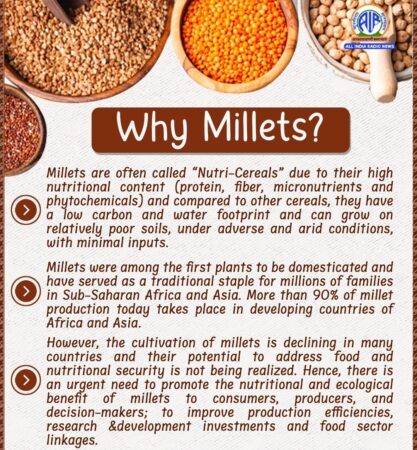
2023 is the International Year of Millets
March 9, 2023
By Bakers Journal
 2023 is the Year of the Millets, as declared by the United Nations General Assembly in March 2021 citing their important contribution to livelihood generation, food and nutritional security in various parts of the world.
2023 is the Year of the Millets, as declared by the United Nations General Assembly in March 2021 citing their important contribution to livelihood generation, food and nutritional security in various parts of the world.
The Government of India originally proposed the designation and it was supported by 72 countries and the UNGA.
According to the the Consulate of India in Toronto, millets are a rich source of protein, fibre, minerals, iron, calcium, magnesium and phosphorous, and have a low glycemic index.
The term is derived from the French word mille, which means thousand, implying a handful of millet can hold up to thousands of grains.
They list further benefits: Millets reduce the risk of hypertension, diabetes and cardiovascular diseases and beneficial in treating and prevention of gallstones and stomach ulcers. These are nutritionally dense and reduce anaemia, liver disorder and asthma. Millets are rich in antioxidants and lowers blood glucose response and reduce the risk of Type-II Diabetes. Millets high dietary fibre provides hunger satisfaction and helps reduce obesity.
India is a major producer of millets, accounting for 80 per cent of Asia’s production and 20 per cent of global production. India’s average yield of Millets (1,239 kilogram/hectare) is also higher than global average yield of 1229 kilogram/hectare. India consumes nearly 38 per cent of the consumption of its domestic produce.
There are many different kind of millets, each with their own benefits and ways to include them in the diet. Indian Millets are mainly classified into two types based on grain size – Major Millets (Sorghum, Pearl Millet, and Finger Millet), which require minimal processing after harvesting and can be directly used after being washed and Minor Millets (Foxtail Millet, Proso Millet, Kodo Millet, Barnyard Millet, Little Millet), which are husked grain and comes with indigestible seed coat which separated prior to consumption as a part of post-harvest processing.
Eating whole grains such as wheat, rice, lentils and pulses is a common practice that has been recommended by experts. Millet is also one such ancient superfood that has been garnering interest in the recent past. The Millet is a healthy grain and has a mild taste. It is easy to dress up with vegetables, herbs and proteins. Like most grains, it can pair with just about anything, but has a nuttier, more flavorful taste.
Millets are one of the oldest foods, these are the small-seeded hardy crops which can grow well in dry zones or rain-fed areas under marginal conditions of soil fertility and moisture. They are cultivated in low-fertile land, tribal and rain-fed and mountainous areas. Due to their short growing season, millets can develop from seeds to ready to harvest crops in just about 65 days, a trait of vital importance in thickly populated regions of the world. If stored properly, millets can keep well for two years or beyond.
Learn more about diversified millet value-added technologies.
Print this page
Leave a Reply